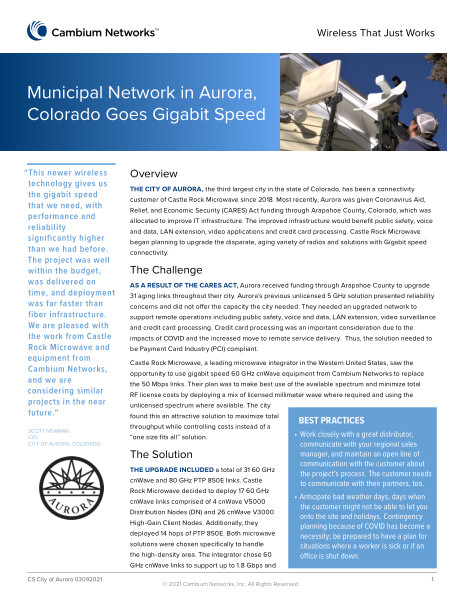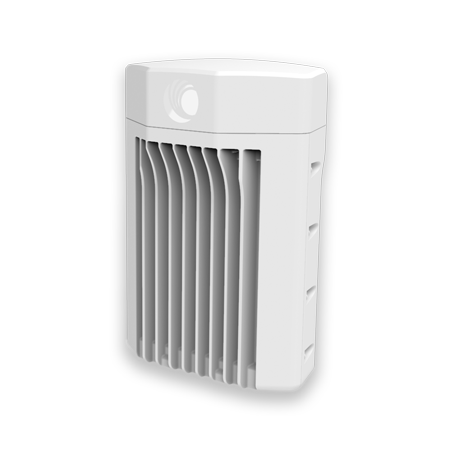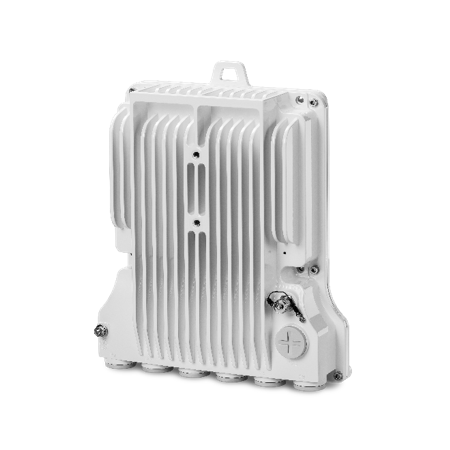Overview
The city of Aurora, the third largest city in the state of Colorado, has been a connectivity customer of Castle Rock Microwave since 2018. Most recently, Aurora was given Coronavirus Aid, Relief, and Economic Security (CARES) Act funding through Arapahoe County, Colorado, which was allocated to improve IT infrastructure. The improved infrastructure would benefit public safety, voice and data, LAN extension, video applications and credit card processing. Castle Rock Microwave began planning to upgrade the disparate, aging variety of radios and solutions with Gigabit speed connectivity.
The Challenge
As a result of the CARES Act, Aurora received funding through Arapahoe County to upgrade 31 aging links throughout their city. Aurora’s previous unlicensed 5 GHz solution presented reliability concerns and did not offer the capacity the city needed. They needed an upgraded network to support remote operations including public safety, voice and data, LAN extension, video surveillance and credit card processing. Credit card processing was an important consideration due to the impacts of COVID and the increased move to remote service delivery. Thus, the solution needed to be Payment Card Industry (PCI) compliant.
Castle Rock Microwave, a leading microwave integrator in the Western United States, saw the opportunity to use gigabit speed 60 GHz cnWave equipment from Cambium Networks to replace the 50 Mbps links. Their plan was to make best use of the available spectrum and minimize total RF license costs by deploying a mix of licensed millimeter wave where required and using the unlicensed spectrum where available. The city found this an attractive solution to maximize total throughput while controlling costs instead of a “one size fits all” solution.
The Solution
The upgrade included a total of 31 60 GHz cnWave and 80 GHz PTP 850E links. Castle Rock Microwave decided to deploy 17 60 GHz cnWave links comprised of 4 cnWave V5000 Distribution Nodes (DN) and 26 cnWave V3000 High-Gain Client Nodes. Additionally, they deployed 14 hops of PTP 850E. Both microwave solutions were chosen specifically to handle the high-density area. The integrator chose 60 GHz cnWave links to support up to 1.8 Gbps and PTP 850E Radios at 10 Gbps. During the project planning stage, Castle Rock heavily used Cambium’s LINKPlanner configuration tool and the online learning center’s manuals and guides.
Project installation began on November 4, 2020. During this time, Castle Rock Microwave also had to navigate with other stakeholders in the city. While the city’s IT group owns and operates the radios, those radios are installed in numerous facilities owned and operated by other city departments.
In January 2021, cutting the traffic over from the old links to the first cnWave links was simple; since the system was overbuilt (old links kept in operation), the customers went down for a very short period of time while traffic was moved over to the new links. The project was completed in March 2021.
The Results
Now, the Cambium equipment is supporting densely populated areas, primarily benefitting public Wi-Fi, the City’s enterprise network and credit card processing. Encryption on all the links ensure proper security when transacting credit cards, whether at golf courses,
sports park concessions or the Aurora Reservoir.
Initially, one of the driving factors behind the upgrades was the conversion of public facilities in Aurora to distance learning centers to accommodate more students. With COVID, creating better connectivity in additional spaces for these students was a high priority. Those benefitting are children who need to be supervised in a public setting with adequate distancing during school shutdowns.
With the project completed, Aurora has begun cutting over production traffic to the new infrastructure. The City of Aurora has been highly satisfied with the project, with positive feedback being given by the Chief Information Office of the city.


